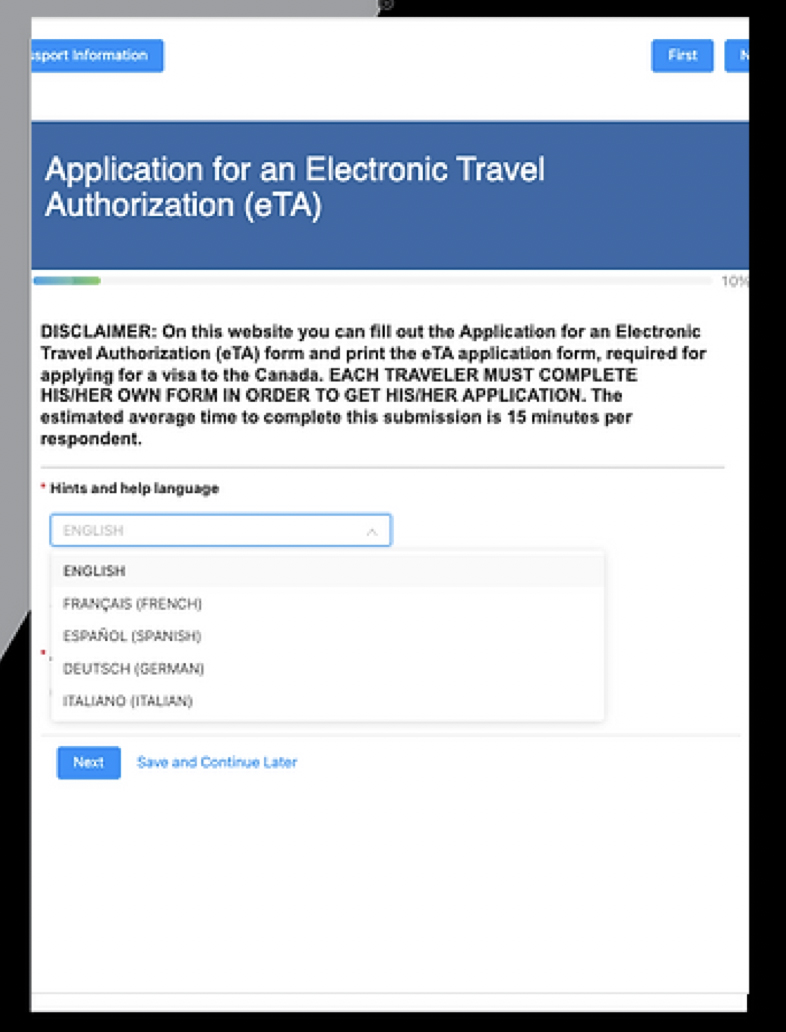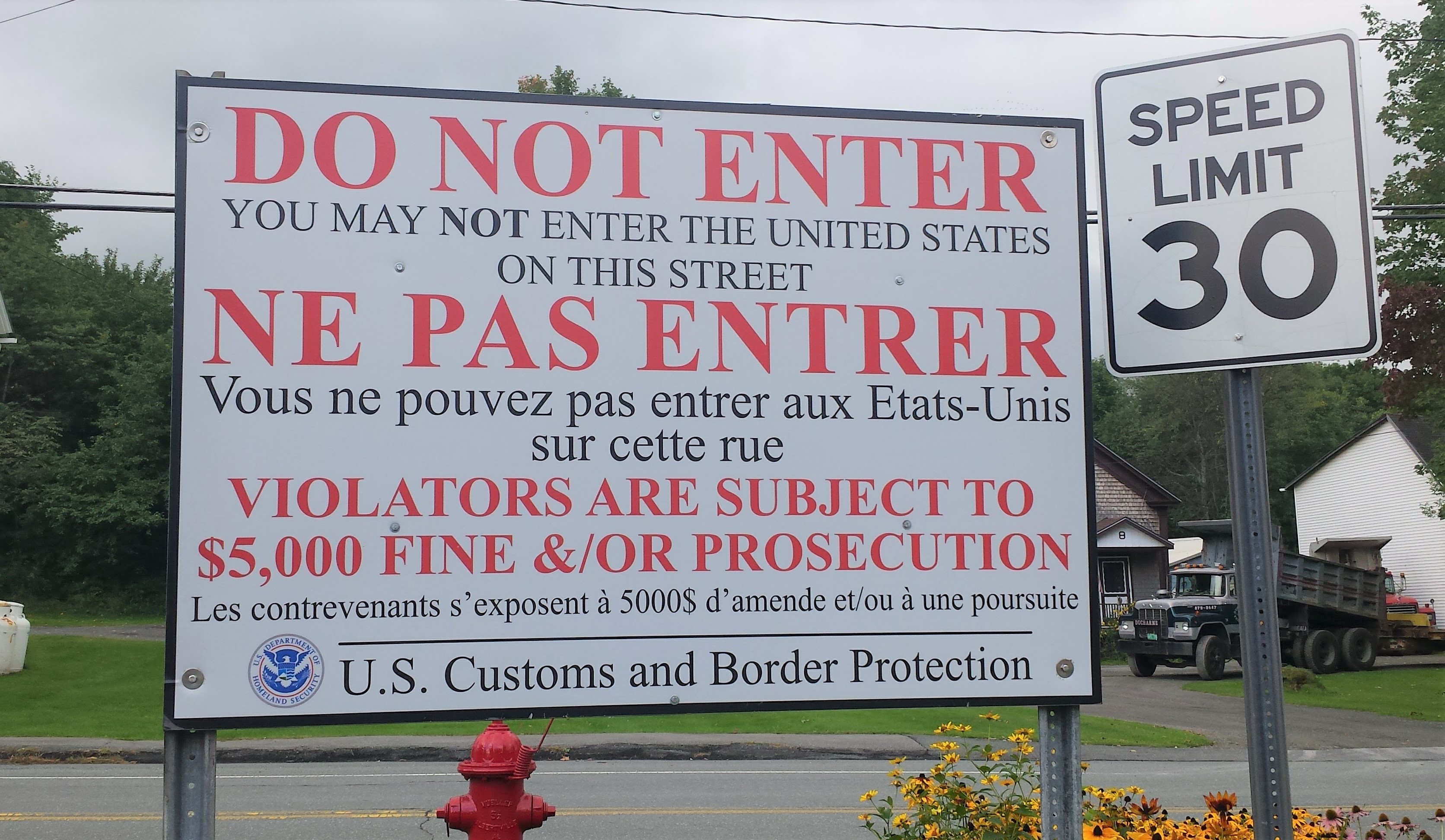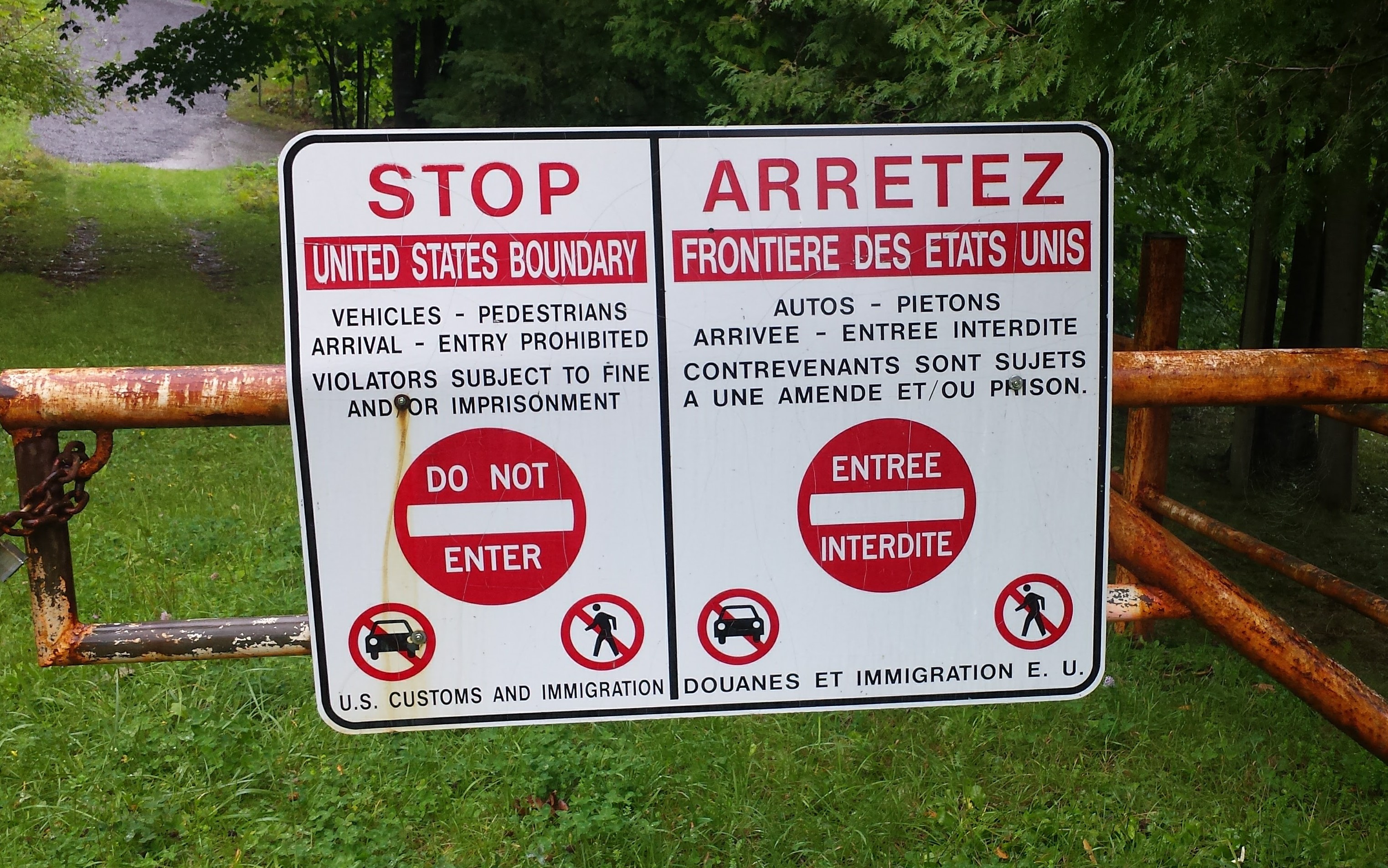The Canadian border is back in the news, with headlines proclaiming that illegal immigration there has suddenly spiked more than 800 percent in one busy sector recent months. Amid a fresh outbreak of “what-to-do-doism”, the Biden administration redeployed 25 Border Patrol agents from the besieged southern border to the far northeast corner of America’s border with Canada, the Border Patrol's Swanton Sector (including New Hampshire, Vermont, and part of New York).
The agents are to intercept what appears to be a huge spike in crossings by mostly Mexican nationals flying over the United States into Canada and then crossing the border southward, along with other nationalities in smaller numbers.
But so far left out of public reporting and government responses is that the reason for the northern border surge is one particular Canadian policy that, if ever acknowledged, could be quickly and easily remedied between diplomats on both sides. But likely never will.

The catalyst of mainly Mexican northern border crossings is a policy that Canada’s Prime Minister Justin Trudeau implemented on December 1, 2016. On that day, Trudeau rescinded the requirement that Mexicans seeking to travel to Canada obtain visas. The prime minister replaced the visa requirement it with a pro-forma electronic travel authorization (eTA) visitor’s pass, a $7 online affair, that allowed Mexicans to fly in at will like most American citizens.
Now, Mexican nationals are using Trudeau's visa-free visitor’s pass in escalating numbers to fly in and then cross south into America.
They are doing so because, on the southern border, the Border Patrol is applying the last months of Title 42 rapid expulsions against most Mexicans, while admitting many of other nationalities under humanitarian parole. In short, Mexicans are at the bottom of the food chain right now among nationalities enjoying wholesale Biden administration admittances at the southern border. But those with the price of an air ticket have options.
Trudeau’s fast-pass, visa-free loophole for Mexicans to fly into Canada may seem inexplicable unless seen through the prism of Canadian politics.
Trudeau’s 2016 policy was a conspicuous reaction to Donald Trump's election weeks before. The visa requirement for Mexicans was there for good reason. Trudeau’s predecessor put it in place in 2009 because prior to that Mexicans were abusing the visa waiver to stake bogus asylum claims on a mass scale. It obviously had to go.
Trudeau, though, happily returned that asylum abuse to pacify his progressive liberal base who treasured such abuse.
"Lifting the visa requirement will deepen ties between Canada and Mexico and will increase the flow of travelers, ideas, and businesses between both countries,” Trudeau said in a November 2016 announcement about his plan to restore visa-free travel to Mexicans.
When he did it in December 2016, the result was both predictable and predicted at the time. As Trump went to work to implement his border-tightening plans, the northern border experienced a significant spike, as Mexican nationals flew into Canada on their new $7 visa waiver, filed bogus asylum claims, and when they were declined, crossed south into the United States, just as they are doing once again.
CBP apprehension numbers showed a hefty increase in apprehensions of Mexicans at the northern border after Trudeau lifted the visa requirement. From 2013 through 2016, apprehensions of Mexicans ranged from about 1,400 to about 1,700 annually. Those numbers increased to 2,245 in 2018 and 2,101 in 2019.
The new surge of Mexicans at the northern border is shaping up as far worse than the earlier one during Trump, with 1,604 Border Patrol apprehensions in just the first five months of fiscal 2023.
Trudeau’s 2016 policy toward Mexicans has almost certainly sparked off a new and bigger replay in 2023. And while its 1,604 apprehensions are infinitesimal compared to southern border’s 253,701 apprehensions of Mexicans, there is ample cause for Americans to ask about the Trudeau policy and to question why the Biden administration, in many recent immigration meetings and summits with the Trudeau government, has never demanded its immediate end before the situation worsens.
Mexican Cartel Drug Traffickers and Murderers
By mid-July 2017, after Trudeau restored the visa waiver to Mexicans, leaked Canada Border Services Agency intelligence reports said Mexican cartel operatives — "drug smugglers, human smugglers, recruiters, money launders and foot soldiers" — were turning up in greater numbers than ever before. The cartels began facilitating the human smuggling business of other Mexicans south over the America’s northern border, just as they did all along the southern border.
Global News, which published the intelligence reports in July 2017, quoted them as saying Mexican crime groups such as the ultra-violent Sinaloa cartel had turned up in Canada and would "facilitate travel to Canada by Mexicans with criminal records".

Besides the Sinaloa Cartel, Mexican entrants were identified as belonging to La Familia Michoacana, Jalisco New Generation, and Los Zetas cartels.
For instance, whereas the reports said 37 Mexicans linked or possibly linked to organized criminal groups had entered between 2012 and 2015, 65 involved in "serious crimes" were identified midway through just 2017, compared to 28 in 2015. Another 15 Mexicans cited for national security problems were caught in the first six months of 2017, more than the two previous years combined.
By May 2019, at least 400 Mexican criminals connected to drug trafficking, including sicario hitmen, were plying their trades in Canada, at least half of them in Quebec, according to a May 24, 2019, report in the Toronto Sun and other Canadian media outlets. All had entered through the Trudeau loophole.
By the end of 2019, Canada saw a 1,400 percent spike in the number of bogus Mexican refugee claims, the vast majority naturally rejected, and of associated detentions.
It stood to reason that, when Canada declined Mexican asylum claims, they simply fled south over the thinly patrolled northern American border.
But that was then and this is now, right?
Except that now appears to be the same as then.
Starting in about fall 2022, southern border pressure once again seemed to be squeezing Mexican nationals — and Mexico’s cartel criminals — into the Canadian pipeline.
Of course it would. While the Biden administration was turning back almost all Mexicans caught at the southern border under the pandemic-control measure known as Title 42, Mexicans saw illegal border-crossers from other nationalities obtaining quick release into the United States, often with parole and work permits.
From January to mid-October 2022, 7,698 Mexican asylum seekers took direct flights from Mexico City to Montreal, according to a November 2022 Canadian Press story. The paper quoted officials at nonprofit refugee assistance groups attesting to the fact that most fly to Canada because they found out about Trudeau’s visa-free policy for Mexicans and that they could access government financial assistance while awaiting the outcomes of their asylum applications.
But most of their applications are rejected.
There should be little doubt that cartel operatives using bogus documents are once more using the Trudeau loophole not only to enter Canada, but to then take themselves and those who follow southward into the United States.
In their October 2021 book, The Wolfpack: The Millennial Mobsters Who Brought Chaos and the Cartels to the Canadian Underworld, journalists Peter Edwards and Luis Najera established that the Sinaloa Cartel now has a solid foothold across eastern Canada, with “solid control of cocaine shipments in and out of Canada”. The Arellano Felix group has its foothold in western Canada, particularly in Vancouver and in the state of Alberta.
The Zetas are in Canada “involved with temporary migrant workers”.

Asked in 2023 if Canada’s importance to Mexican organized crime had increased “in recent years”, co-author Luis Najera answered an interviewer this way:
“I would say it has increased since criminal cells moved up north to settle and expand operations here. It is also strategic to have groups operating north of the U.S. border, close to key places such as Chicago and New York, and without the scrutiny of the DEA and rival groups.”
So there should also be little doubt that regular economic migrants are once again paying the Mexican cartels in Canada to organize their southward crossings into the United States before or after they lose or abandon their pro-forma Canadian asylum claims.
The problem — for the Mexicans — is that Canada seeks to quickly deport those who are declined for asylum as most Mexicans are and who, knowing rejection is the most likely outcome, often abandon their initial claims rather than wait for the inevitable. Or don’t bother filing them at all.
In summary, three factors explain why Mexicans are now surging south over the American border: Canada’s policy allowing them easy, visa-free flights in, Canada’s willingness to deport them after they inevitably become illegally present there, and an irresistibly alluring Biden administration policy that suspended almost every kind of interior deportation, creating a sanctuary nation sucking them southward out of Canada.
Explanations for Non-Mexican Southward Crossings
Similar circumstances are likely leading non-Mexicans to cross south from Canada.
More than half of the 2,856 apprehensions at the northern border in just the first four months of FY 2023 — 1,604 — were Mexican nationals, according to CBP apprehension data, which includes another 17 nationalities and “other.” Those 17 nationalities accounted for an additional 1,095 apprehensions, while 157 made up the ambiguous “other” category.
For example, about 90 Romanian gypsies (also known as Roma) were apprehended crossing south from Canada in the first four months of 2023. This one is explainable. Trudeau’s 2016 move restored visa-free visitation to Romanians, immediately sparking off flights into Canada and crossings over the southern border that obviously continue today.
But none of the other 16 nationalities are on Canada’s visa-free list of more than 50 countries.
How could these 1,095 have gotten into Canada and, like the Mexicans and Romanians, enacted their southward illegal crossings?
There are two likely explanations. One is yet another Canadian loophole that illegal immigrants who are inside the United States can avail themselves of if they crossed the southern border and were rejected for American asylum.
A “safe third country agreement” between Canada and the United States prohibits anyone from claiming asylum if they’ve already filed for it in either country.
But only if they try to claim it at an official port of entry.
American asylum rejectees can get a second bite at the apple if they illegally enter Canada between ports of entry. And a popular spot in upstate New York known as the “Roxham Road” crossing is flooded with illegal immigrants these days, presumably rejected U.S. asylum seekers, crossing to take a gamble on Canadian asylum.
But what happens when Canada rejects them and starts hunting them down for deportation?
Are these the non-Mexicans now starting to return to America, the sanctuary nation under Biden? There’s precious little media reporting on the question, but it seems likely.
A second possibility is that Trudeau’s ambitious immigrant importation policy, which has flown in hundreds of thousands of foreign nationals from throughout the world, is responsible. After Trump’s election, Trudeau put himself out to his base as the ultimate anti-Trump on immigration, rolling out what would become that nation’s most-ambitious-ever plan to admit immigrants, nearly one million over a three-year period.
Could some portion of those to whom Canada is granting entry never have intended to stay in that country, and be heading south into the United States?
That, too, seems likely.
Northern Border Surge Likely to Only Get Worse
In the knowledge that easily reversible policy choices are behind what’s happening on the northern border, the Biden government’s northward deployment of 25 Border Patrol agents should be seen as the empty gesture it is.
Those agents will do nothing to slow the gathering northern tide because their deployment treats the consequences of underlying causal policies — and not the causal policies themselves, which are never even publicly discussed so that they can be addressed.
Prime Minister Justin Trudeau, like President Joe Biden, could easily flick the switches to off and end much of the influx almost overnight. Trudeau could reinstitute visas for Mexicans, for starters, with a wave of his hand. The Biden administration, perhaps thinking of Mexican cartel operatives flowing in with the illegal immigrants, could demand that move and negotiate a closure of the safe third country agreement’s land border loophole.
A March 7 meeting in Washington between DHS Secretary Alejandro Mayorkas and his Canadian counterpart, Immigration Minister Sean Fraser, shows none of that is likely to happen.
Both governments are run by progressive liberals who want as much immigration as possible, legal or otherwise. After his meeting with Mayorkas, Fraser indicated he’s going to let it all ride when he told reporters that the northern border problem is not one that will respond to quick fixes.
“Migration is a reality that we’re going to continue to deal with,” Frasier said, indicating inaction.
Trudeau and Biden will get away with it, too, because American media seem disinclined to report anything about these causal Canadian policies or their consequences.
